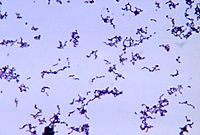
Photo from wikipedia
Cutibacterium acnes (C. acnes), a Gram-positive anaerobic bacterium, proliferates in hair follicles and pores and causes inflammation in the skin of young people. The rapid growth of C. acnes triggers… Click to show full abstract
Cutibacterium acnes (C. acnes), a Gram-positive anaerobic bacterium, proliferates in hair follicles and pores and causes inflammation in the skin of young people. The rapid growth of C. acnes triggers macrophages to secrete proinflammatory cytokines. Pyrrolidine dithiocarbamate (PDTC) is a thiol compound that exerts antioxidant and anti-inflammatory effects. Although the anti-inflammatory function of PDTC in several inflammatory disorders has been reported, the effect of PDTC on C. acnes-induced skin inflammation remains unexplored. In the present study, we examined the effect of PDTC on C. acnes-induced inflammatory responses and determined the mechanism by using in vitro and in vivo experimental models. We found that PDTC significantly inhibited the expression of C. acnes-induced proinflammatory mediators, such as interleukin-1β (IL-1β), interleukin-6 (IL-6), tumor necrosis factor-α (TNF-α), cyclooxygenase-2 (COX-2), inducible nitric oxide synthase (iNOS), and NOD-like receptor (NLR) pyrin domain-containing 3 (NLRP3), in mouse-bone-marrow-derived macrophage (BMDM) cells. PDTC suppressed C. acnes-induced activation of nuclear factor-kappa B (NF-κB), which is the major transcription factor for proinflammatory cytokine expression. In addition, we found that PDTC inhibited caspase-1 activation and IL-1β secretion through suppressing NLRP3 and activated the melanoma 2 (AIM2) inflammasome but not the NLR CARD-containing 4 (NLRC4) inflammasome. Moreover, we found that PDTC improved C. acnes-induced inflammation by attenuating C. acnes-induced IL-1β secretion in a mouse acne model. Therefore, our results suggest that PDTC has potential therapeutic value for the amelioration of C. acnes-induced skin inflammation.
Journal Title: International Journal of Molecular Sciences
Year Published: 2023
Link to full text (if available)
Share on Social Media: Sign Up to like & get
recommendations!